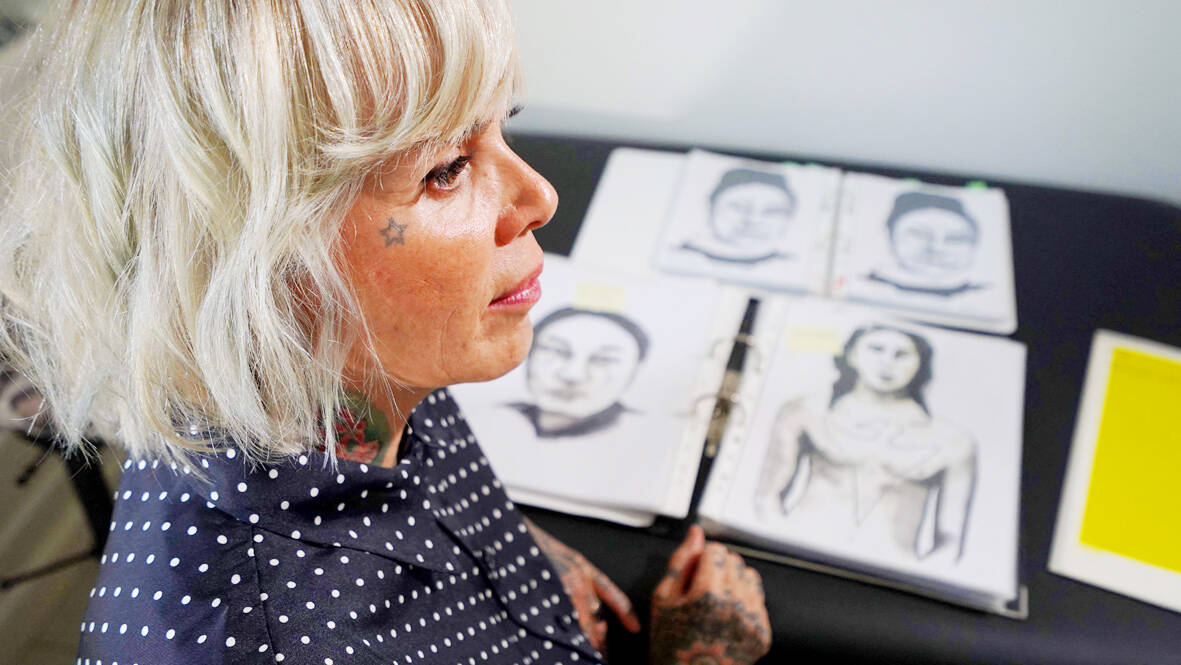Andu Schiodt Pikilak has dark dashes on her forehead descending into a deep “V” like geese flying in formation, an Inuit tattoo she sees as a rebirth for both her and Greenlandic culture.
“We’re going back to our roots,” said the reserved 61-year-old psychologist who took the plunge seven years ago, before adding other tattoos to her forearm and fingers.
“The tattoos disappeared for many generations and have only recently returned,” Pikilak said in Nuuk, the capital of the Arctic island of Greenland.

Photo: AFP
The territory was a Danish colony from 1721 to 1953, before gradually becoming autonomous in the second half of the 20th century.
Inuit tattoos in Greenland — similar to those inked in other Inuit cultures, notably in Canada — are primarily worn by women.
They were never formally banished but disappeared when Greenland was colonized.
But for Pikilak, “it’s like they were always there.”
Her friends and family applauded her choice and she has received few disapproving looks, she said in her modern apartment adorned with a few traditional objects like Inuit carving knives.
For Eva Nielsen, the decision to get a traditional facial tattoo, called a tuniit — hers consists of 12 lines on her chin — was the fruit of a long personal reflection, and a way of reappropriating her Inuit heritage.
“It’s a symbol. I want to carry my culture within me,” the 33-year-old said.
She grew up mainly in Denmark, with a Danish father and a Greenlandic mother.
“It’s not just a butterfly tattoo, it has real meaning. I was so happy when I looked in the mirror the first time.”
TATTOOED MUMMIES
The oldest known accounts of Greenlandic Inuit tattoos date back to the 15th century, thanks to mummies found in the town of Qilakitsoq.
Of the eight bodies discovered in 1972 — found in excellent condition thanks to the cold and dry climate — five were women, all of whom bore facial tattoos.
“The tattoos are linked to family relations and your status in society at the time, and what you were able to do,” said Aviaaja Rosing Jakobsen, the curator of the museum housing the mummies, herself tattooed.
Greenlanders have only recently begun rediscovering and reappropriating their cultural heritage.
“Growing up in Greenland in the post-colonial era, when we were a province of Denmark... the narrative was that the Inuit who came before us were different people from us,” recalled Maya Sialuk Jacobsen, a professional tattoo artist in her 50s who splits her time between Nuuk and Denmark.
“It took me a while to understand that this wasn’t true.”
Her interest in ritual tattoos was sparked a decade ago when she was put on bed rest after a shoulder operation.
She discovered they were traditional across the far north, from Siberia to Greenland, but their designs varied depending on the surroundings, hunting methods and local beliefs.
FEMALE AMULETS
The practice, primarily for women, is “an amuletic form of tattooing,” said Jacobsen. “The tattoos had a job to do.”
The biggest taboos in Inuit culture were birth, menstruation and death.
“A woman in her physicality alone is breaking taboos just by being... Her amulets have the power to erase the taboos she’s breaking,” Jacobsen said. “There are about 15 different amulets that are put together in various ways according to which tribe you are from and which type of hunting was done. There are as many patterns as there are women,” she said.
A needle made of animal bone is used to make the markings — the same kind of needle used for sewing — and as a result the designs are relatively simple, “dots and lines, basically,” Jacobsen said.
Greenlandic Inuits nowadays get traditional tattoos for their own personal and political reasons rather than for the community’s benefit, which was the main reason in the past, she said.
“People are super hungry to understand their culture (and) represent the culture,” said the self-taught researcher.
She is having the tattoos on her forehead and chin removed, as they represent Canadian Inuit designs and not Greenlandic ones, something she was not aware of when she first developed an interest in the tradition.

Before the recall election drowned out other news, CNN last month became the latest in a long line of media organs to report on abuses of migrant workers in Taiwan’s fishing fleet. After a brief flare of interest, the news media moved on. The migrant worker issues, however, did not. CNN’s stinging title, “Taiwan is held up as a bastion of liberal values. But migrant workers report abuse, injury and death in its fishing industry,” was widely quoted, including by the Fisheries Agency in its response. It obviously hurt. The Fisheries Agency was not slow to convey a classic government

Not long into Mistress Dispeller, a quietly jaw-dropping new documentary from director Elizabeth Lo, the film’s eponymous character lays out her thesis for ridding marriages of troublesome extra lovers. “When someone becomes a mistress,” she says, “it’s because they feel they don’t deserve complete love. She’s the one who needs our help the most.” Wang Zhenxi, a mistress dispeller based in north-central China’s Henan province, is one of a growing number of self-styled professionals who earn a living by intervening in people’s marriages — to “dispel” them of intruders. “I was looking for a love story set in China,” says Lo,

It was on his honeymoon in Kuala Lumpur, looking out of his hotel window at the silvery points of the world’s tallest twin skyscrapers, that Frank decided it was time to become taller. He had recently confessed to his new wife how much his height had bothered him since he was a teenager. As a man dedicated to self-improvement, Frank wanted to take action. He picked up the phone, called a clinic in Turkey that specializes in leg lengthening surgery — and made a booking. “I had a lot of second thoughts — at the end of the day, someone’s going

The next few months will be critical in determining the future of the Taiwan People’s Party (TPP). Following party founder Ko Wen-je’s (柯文哲) arrest in September last year, Huang Kuo-chang (黃國昌) effectively became the de facto face of the party and officially became chairman in January. While Ko frequently criticized the ruling Democratic Progressive Party (DPP) and insinuated sinister intentions on the part of the DPP’s New Tide faction, his era was largely defined by the TPP slogan “rational, pragmatic, scientific,” albeit defined largely by his definition of what that meant. The tone and language used by the TPP changed dramatically